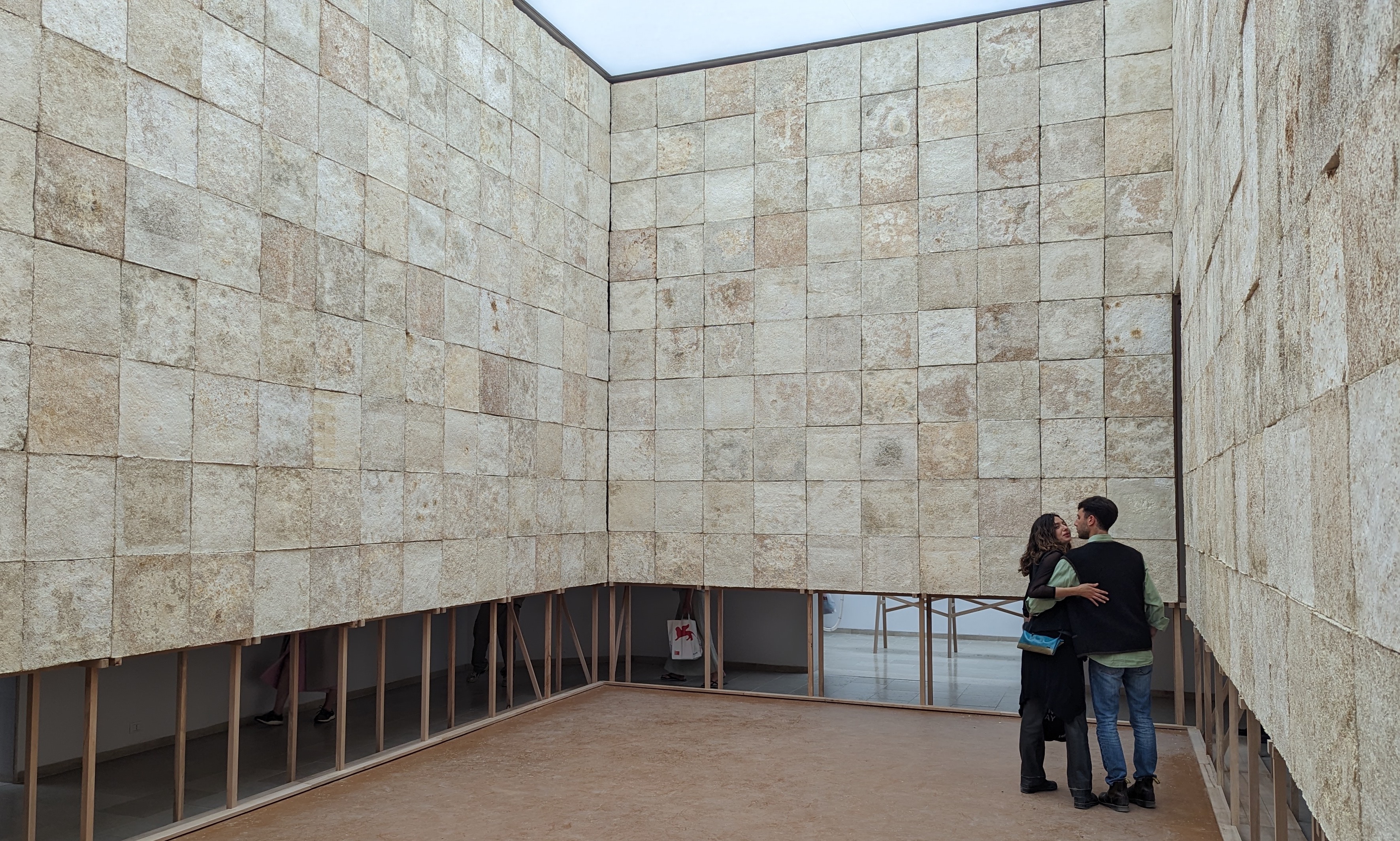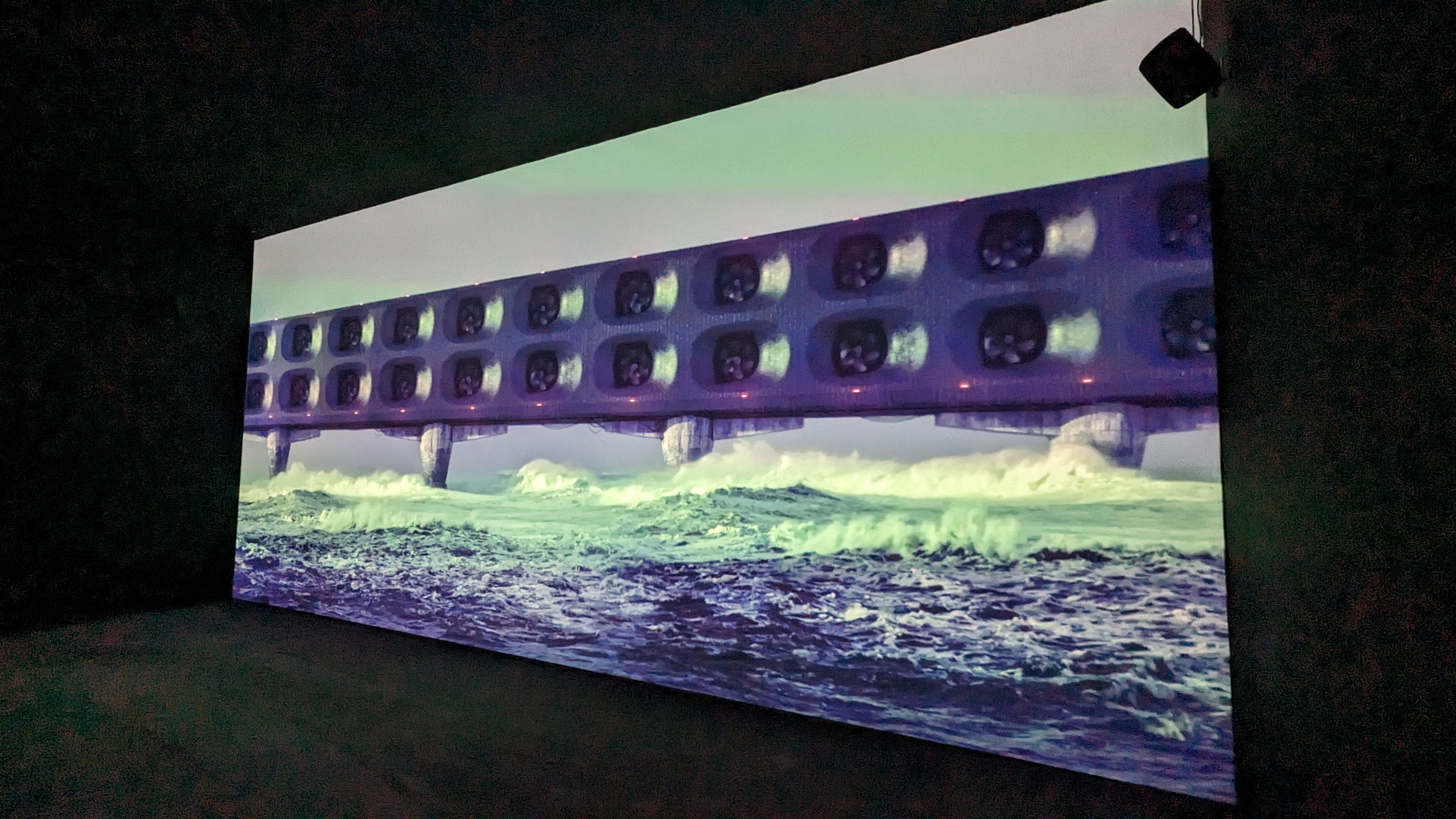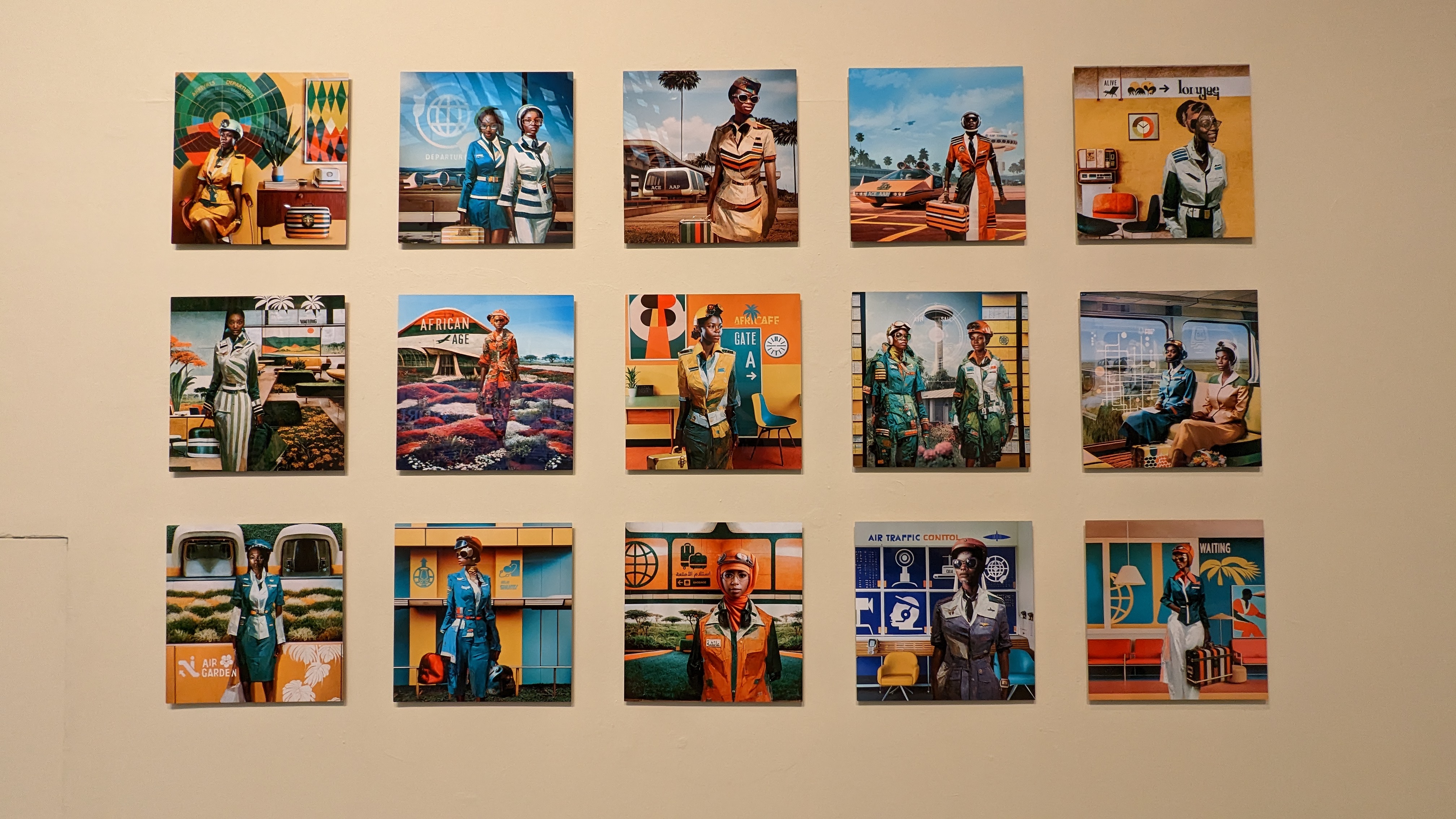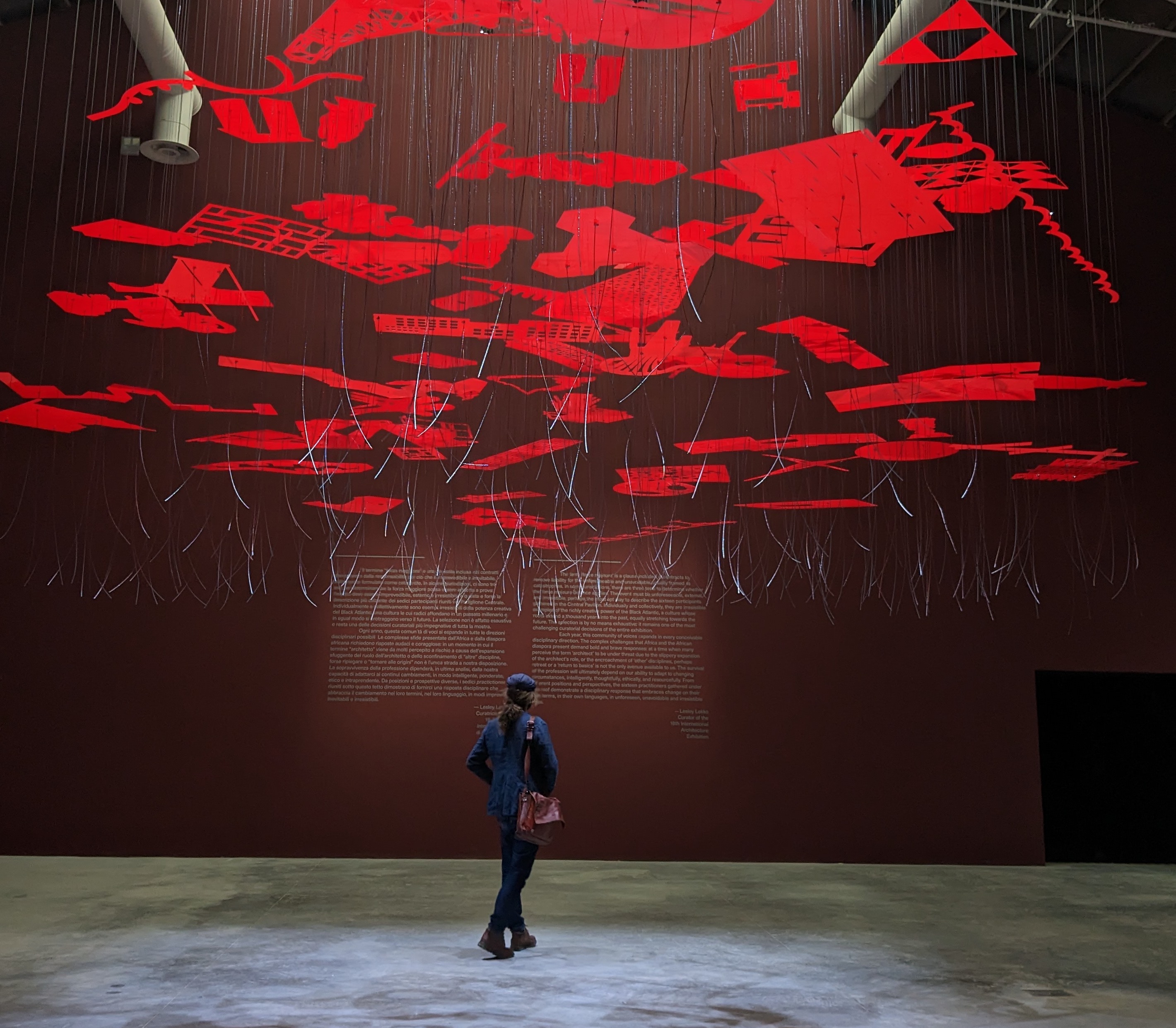Venice Biennale: Walking through a radical, global, infectious revolution
The 18th Venice Architecture Biennale was derided by conservatives for not having enough buildings. But as climate change finally hits Europe head on, the Biennale offers glimpses of a green, non-colonial, riotously imaginative global future - and lets you experience it in real time.
As you walk into the bright, cavernous hall, splayed with rectangles of green and gold, the first thing you see is an old-fashioned departure board. Black flaps with white letters clatter as they flip through a volley of destinations: Rio de Janeiro, Port-au-Prince, Montego Bay. In front of it are low wooden benches, inviting you to dump your bag and rest a while after the passport queue. Around the room, job ads abound for space engineers and ground services managers, pilots and porters. Holiday posters show families boarding space shuttles, towing behind them little hovercrafts piled with designer luggage and perched upon by kids in enormous sunglasses.
All the people in all the posters are Black, all impossibly chic, and all exist in a nostalgic-futuristic future-past, somewhere in the early 1970s. The style is American postwar abundance meets 70s funk, all soaked in bright, vivid pan-African fashion. It’s a parallel universe where, shortly after the last of the old colonial powers have been ejected from the continent, African scientists discover a way of using biofuel to propel suborbital shuttles, and use it to build a network connecting Africa to the hubs of the great African diaspora - sites of slave trade and revolution. In this reality, the civil wars, the coups, the imperialist machinations of the former colonial overlords, the genocides, the grift, didn’t happen. The conflicts hinted at - can we build a new spaceport on a rare wetlands reserve? - are environmental, political, and civic. The Africa we catch glimpses of is prosperous, confident, at ease; and the former colonial superpowers and the eternal juxtaposition between the “developed” and the “developing” countries are simply not there. In this Afrofuturist space lounge, the Global North is lightly, casually ignored.
The vintage style of the display evokes sweet nostalgia for a life unlived that would make a Mad Men set designer weep. But the sci-fi focus tells us this is the future - all the nearer, and all the more possible, for being situated in a past: not a hypothetical future but one that, in another world, already happened.

A room build of mushrooms in the Belgium pavilion at the Venice Biennale. Photo: Dimi Reider
Unlike most exhibits on post colonialism, you don’t come out part awe-stricken, part aghast. Unlike most exhibits on climate change, you don’t come out despairing; You come out amused, uplifted, moved. Fuck it, you think to yourself. It could happen: a green, non-colonial, non-racist, prosperous future. I’ve just seen it happen. Why not?
*
The departure hall - work of Nigerian-American artist KidCadaver - is at the back of the main pavilion of the 18th Venice Architecture Biennale. The Biennale’s title is Decolonisation and Decarbonisation, a welcome departure from the rarified, apolitical, aloof iterations of the world’s oldest and most important architectural event. It’s the youngest Biennale by average age, and the first Biennale with a majority of Black participants - not a token nod to minorities in the global North, but as more faithful representation of the global majority, of the global South.
None of this advance information prepares you for the sheer jaw-dropping abundance of the Biennale, nor for the ferocious optimism of its imagination, nor for just how elastic the boundaries of its subject matter are. Although there is plenty here for the architect, the city planner and the engineer, it is primarily an exhibition of what buildings mean: what happens below them, above them, around them, and within them, what role they play in our lives, what stories they grow out of, what stories they make possible, what stories and lives they mangle and constrain.
And as if in a perfectly scripted film, this climate-themed exhibition in the most Italian of cities coincided with climate chaos itself "arriving" in Italy, or at least making itself known more vividly than ever before. Weeks of drought broke with torrential, completely unseasonal rainstorms that brought down lethal landslides, flooded railways, and sent long-buried rivers exploding upwards through streets, shops and homes in the midst of Italian cities. This summer is a preview of a future for Italy and for southern Europe that has already arrived, and that will be creeping northwards next. The exhibition is a chance for Europe to learn what it can from more experienced veterans of climate adaptation in the Global South; the sooner, the better.
To no one's surprise, this timely, hyper-imaginative celebration of architecture was eviscerated by conservative critics. The Telegraph, cowering before the spectre of the ultimate act of deconstruction, inquired if “British architecture has given up on actual buildings.” Patrik Schumacher, the ultra-capitalist heir to the architectural empire of Zaha Hadid, went further, asserting the Biennale contains “no architecture whatsoever” and warned that we are “witnessing… the discursive self-annihilation of the discipline.”

It feels daft to have to reassure you on this, but this, of course, is tosh: architecture is everywhere in the Architecture Biennale, from stupendous spaces - like the Borgesian labyrinth of the Uzbekistan pavilion - to recreations of indigenous community architecture, to more than enough scale models of buildings from - residential to national - to gladden any architecture student’s heart.
But it’s no coincidence that Leslie Lokko, the curator of this astonishing event, is both an architect and a best-selling novelist. Every other exhibit, every other pavilion, feels like a walk-in story - be it an epic saga or an inside joke. In the Belgian pavilion, an entire room has been constructed of light, cream-coloured slabs pressed out of material that looks like straw but smells like mushroom soup. They are, indeed, mycelia, and the pavilion plays around a future where we’ve decoded mushroom language and struck up an alliance with the shrooms to produce sustainable, self-repairing building blocks. On the wall are fragmented, “translated” excerpts of mushroom graffiti exoriating humans: not all mushrooms are entirely on board.
The British pavilion celebrates inner London’s diasporas through mini-documentaries that are so heartfelt they make you viscerally miss the redbrick, cluttered streets of Peckham in the heart of Europe’s most self-consciously classical, marbled city. The Finns, cheerfully practical, centred their little pavilion around a gorgeous, minimalist, wood panelled… dry toilet. That sylvan throne is accompanied by monologues from poker-faced scientists from the near future, expressing their astonishment at just how much water we wasted in our commodes before the Finnish way took over. Sadly, the exhibit itself is not experiential, but the Finns took care to plaster almost every other toilet in town with militant stickers.
The Turkish exhibit, perhaps the most informationally dense, shows spectacular examples of carving out new uses from old buildings, sparing the planet the carbon (and worse) released into the atmosphere during demolitions. And in the main exhibition hall, the never-ending Arsenale, a gigantic screen shows slow, awestricken pans over enormous carbon-sucking machines hovering over seas, desert, forests and cities - in the film’s telling, the result of 300 million employees of the fossil fuel industries collectively rising to throw their skills and expertise into removing carbon from the atmosphere. It’s like the new Dune blockbuster, franchise, except with a purpose. The machines look as epic as any high-budget Hollywood movie, but they also look battered, rusty, clunky, improvised: something that could be built.
And the Brazil pavilion, winner of this year’s top prize and perhaps the most considerately political part of the exhibit, pulls down one of the foundational myths of postwar architecture - Oscar Neymar’s Brasilia. Rather than celebrate the brutalist capital built seemingly out of nowhere, the curators show the indigenous land still lying underneath this masterpiece and the indigenous communities relegated to the margins of political, administrative and urban life around that ostensibly shrine to liberation and democracy.

There’s no shortage of ways to instigate radical change. Some require genuine revolution - the radiotherapy of social change making: a violent bombardment of a concentration of cancerous cells that ail a country, even at the price of healthy tissue suffering catastrophic damage, too; even at the price of killing the patient. Some require radical horizontal action - think mass civil disobedience on the scale of Tahrir, Maidan, or Tbilisi. And some is a revolution of the imagination: not a propagation of utopia, still less the forcing of one, but an invitation to experience, briefly but viscerally, what a different reality or a liveable future can be like.
The Biennale is just such a space - a psychedelic, intoxicating, almost lurid mash-up of a revolutionary exhibition - marking a turning point in accepted artistic thinking, something like the Exposition Internationale du Surréalisme in Paris in 1938 and a momentous horizontal revolutionary space: a Maidan or a Tahrir Square.
Walking around the Biennale you feel like you’re seeing shards of yet to be assembled into something new. But you already feel them pulsating toward each other, yearning to connect.
To an activist, this assertion immediately invites suspicion, if not ridicule: a bit like saying the Met Gala is where change is gonna come, or that the Grand National is the new Occupy. Grandiose, rarefied and restrictive, the Venice Biennale seems to negate radicalism by its very essence. And what kind of revolution charges you for entry, anyway?
These are fair points, but the answer is not entirely straightforward. First of all, all revolutions have a price - usually much higher than the price of an exhibition ticket, or even a plane ticket. Access to revolutions is unequal (in fact, the more radical and classically militant a revolution, the more privilege plays a part in who gets to sit on a committee and who gets to face the bayonets.)
Second, not all revolutions have the same mechanism and operate on the same timeframe. Some fail; some resolve overnight; others over rounds upon rounds of civil war. Others, still, take decades to emerge out slow seeds, born from cross-pollination of ideas by thinkers, artists and practitioners who would not have met one another if they hadn't been brought to this one space. Experiencing the latter kind revolution is a bit like walking through a field or a forest: anyone can enter and anyone can leave, but most everyone leaves a little altered, carrying stubborn seeds of change and inspiration pollen clinging to their clothes.
This latter type is the kind of revolution this Biennale is - you can feel it, but you can barely see, with your naked eye, the processes it's already kicked off.
Back in the Brazilian pavilion, one of the texts upon the wall introduces the idea of “archeology of the future.” In its immediate context, the artist simply means that the “primitive” sustainable indigenous techniques nowadays relegated to archeology may well outlive the accomplishment and failures of industrialism, and may once again be relied upon to sustain humanity in a post-climate-crisis world. (Indeed, climate change is progressing so rapidly that Spain has already started to re-excavate irrigation channels built before the medieval Christian expansion by Moors, as if precisely to prove the Brazilian's point about non-Western sustainability techniques coming once again to the forefront.)
But "archeology of the future" seems to apply also to the entire Biennale. Visiting it is a bit like being Dr Who, spotting some artefact from the year 3800 AD in a sleepy town in Dorset in 1993. How did this get here? It’s from another era of time and space entirely. Walking around the Biennale, you feel like you’re seeing the shards that are yet to be assembled into something new. But you feel them pulsating toward each other, yearning to connect.
Ideally, such spaces should be sprung in every major city, and the exhibition that collected the world into itself should explode outward into the world again, not adding barriers to an already unequal, segregated, fragmented sector. But in the meantime, the innumerable encounters between minds and minds, and minds and objects in this mad, little corner of this prim, surreal Old World town will change the world yet. If for no other reason, anyone concerned with change and imagination should make their way to Venice, if only just this once, and take a look.
*
Note: We will be publishing a guide next week on to how to visit the Biennale on a budget - but we already advise you to start booking flight tickets to Venice for September and October, when the tourists hordes are gone and you can fly return from London or Manchester for under £60.
The Lead is now on Substack.
Become a Member, and get our most groundbreaking content first. Become a Founder, and join the newsroom’s internal conversation - meet the writers, the editors and more.





